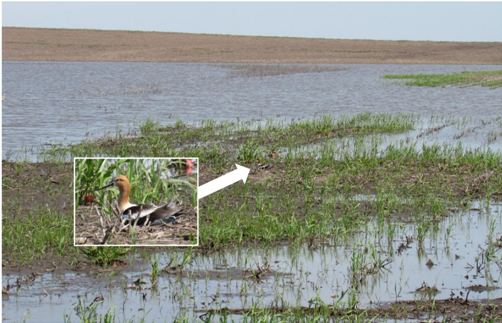Several new publications could help improve conservation planning efforts
Newly published research suggests that vegetated buffers can help reduce the amount of neonicotinoid pesticides in Rainwater Basin wetlands. Researchers collected water samples from 26 wetlands in spring 2015 to measure amounts of a number of neonicotinoid pesticides and invertebrate communities. Results reported in “Neonicotinoid insecticide concentrations in agricultural wetlands and associations with aquatic invertebrate communities” indicate that, while neonicotinoid concentrations were well below Environmental Protection Agency toxicity standards, higher levels were associated with reduced amounts of aquatic invertebrates. The researchers recommend the use of vegetative buffer strips at least 50-meters wide to reduce the amount of neonicotinoids that enter wetlands. This paper was authored by Travis Schepker and Dr. Lisa Webb at the University of Missouri, Dr. Donald Tillitt with the USGS, and Ted LaGrange with the Nebraska Game and Parks Commission.

Another recently published paper suggests that conservation of wetland species with limited movement capabilities, such as some reptiles and amphibians, depends on targeting wetlands that help maintain connectivity in the RWB network. “Future losses of playa wetlands decrease network structure and connectivity of the Rainwater Basin, Nebraska” explores impacts of future anticipated losses of wetlands under several possible scenarios. The authors report that certain wetlands are key in maintaining connections among habitats and movement could be greatly limited for species with low dispersal abilities if those wetlands are lost. Drs. Bram Verheijen and Dave Haukos with Kansas State University and Dr. Dana Varner used RWBJV Annual Habitat Survey data to complete this research.
RWBJV Annual Habitat Survey data was also used in another study to assess the effectiveness of conservation programs in the Rainwater Basin. Area of ponded water in spring ranged from 12-27% for conserved wetlands, compared to 2% for non-conserved wetlands. Similarly, wetland plant coverage ranged from 67-79% for conserved wetlands, but was only 9% for non-conserved wetlands. “Conservation significantly improves wetland conditions: evaluation of playa wetlands in different conservation status” demonstrates the importance of conservation programs and watershed restoration activates. Hong Zhang and Dr. Zhenghong Tang at the University of Nebraska, Jeff Drahota with the USFWS, Ted LaGrange with NGPC, and Dr. Dana Varner and Andy Bishop with the RWBJV authored this paper.

“Roosting habitat use by Sandhill Cranes and waterfowl on the North and South Platte Rivers in Nebraska” is now available online. This research used spring aerial survey data to identify important river segments for migrating Sandhill Cranes and waterfowl. Results suggest that there is little overlap in habitats used by cranes and waterfowl. Information presented in this paper can help managers target their efforts towards areas that can have great benefits for either cranes or waterfowl. Authors of this work include Dr. Dana Varner, Andy Bishop and Roger Grosse (RWBJV), Dr. Aaron Pearse (USGS), Jonas Davis, John Denton and Angelina Wright (Ducks Unlimited), Heather Johnson and Dr. Mark Vrtiska (NGPC), Emily Munter, Kirk Schroeder and Rob Spangler (USFWS).

Also of note, our partners at the Nebraska Game and Parks Commission recently released a report documenting rare and unusual birds nesting in the Rainwater Basin during the summer of 2019. Much higher than average rainfall resulted in ample wetland habitats, attracting a large number of breeding birds. Joel Jorgensen and Stephen Brenner with the Nongame Bird Program described breeding activities for 15 species that rarely nest in this region, including Cattle Egret, Eared Grebe, and American Avocet. The report, titled “Notable avian nesting records from the Rainwater Basin, Nebraska — 2019,” is available online.

















